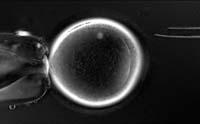Macaque cloning and stem cell research

The scientific journal Nature publishes a method to obtain embryonic stem cells from mature cells of a primate. The research, conducted by biologist Mitalipov and his team at the University of Health and Science of Oregon, consisted of the use of fibroblasts of an adult macaque, that is, connective tissue cells. Specifically, the nucleus of the fibroblast has been introduced into an osculum without a nucleus, which contains the genetic information of that macaque. Subsequently, they have led to the beginning of embryonic development until the blastocyst phase. In fact, in this first phase, embryonic cells are not specialized, so they have the ability to become any type of cell. That is, they are stem cells.
The stem cells obtained with this technique are fully compatible with the adult donor of fibroblast. If this is achieved in humans there would be no problems of rejection, so therapies with stem cells would not have that problem. In spite of the success in other animals, primates could not progress. Mitalipov, however, has made some changes in the passage of the introduction of the adult cell nucleus into the egg and seems to have invented it. Now the method is expected to serve also in humans.
Buletina
Bidali zure helbide elektronikoa eta jaso asteroko buletina zure sarrera-ontzian










